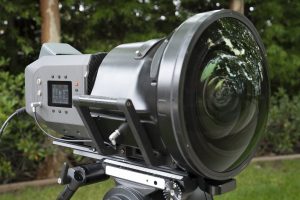Sphere Entertainment – creators of the Sphere LED dome in Las Vegas – has revealed details about its ultra-high-resolution camera system that is being used to capture content for the novel event site.
The dome – which has already hosted U2 concerts – features the world’s largest, high-resolution LED screen which wraps up and around the audience for a “fully immersive visual environment”.
In order to capture content for this 160,000 square foot, 16K x 16K display, the Big Sky camera system was designed by its own Sphere Studios, explains the company.
“Working with Sphere Studios, ST manufactured a first-of-its-kind, 18K sensor capable of capturing images at the scale and fidelity necessary for Sphere’s display. Big Sky’s sensor – now the world’s largest cinema camera sensor in commercial use – works with the world’s sharpest cinematic lenses to capture detailed, large-format images in a way never before possible.”
Specifically, STMicroelectronics made the custom 316Mpixel 18K image sensor for the company, our technology editor has reported. The die measures 99 x 83mm (82.4cm2) – four fit onto a 300mm wafer (right) – and it can capture images at 120frame/s and transfer data at 60Gbyte/s.
“As a leader in the development and manufacturing of image sensors, ST’s imaging technologies and foundry services cater to a wide range of markets, including professional photography and cinematography. Big Sky’s 316-megapixel sensor is almost 7x larger and 40x higher resolution than the full-frame sensors found in high-end commercial cameras. The die, which measures 9.92cm x 8.31cm (82.4 cm2), is twice as large as a wallet-sized photograph, and only four full die fit on a 300mm wafer.”
“Big Sky also allows filmmakers to capture large-format images from a single camera without having to stitch content together from multiple cameras – avoiding issues common to stitching including near distance limitations and seams between images. Ten patents and counting have been filed by Sphere Studios in association with Big Sky’s technology.”

Image: Sphere-Entertainment
See also: Gadget in Extremis – What’s the time, Sr1 strontium optical clock?
 Electronics Weekly Electronics Design & Components Tech News
Electronics Weekly Electronics Design & Components Tech News


